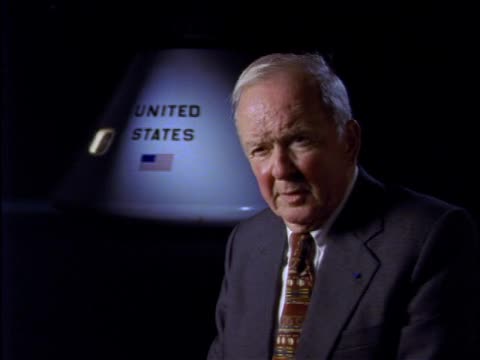NOVA; To the Moon; Interview with Thomas Joseph Kelly, aerospace engineer responsible for working on the Apollo Lunar Module, part 1 of 3
- Series
- NOVA
- Episode
- To the Moon
- Producing Organization
- WGBH Educational Foundation
- Contributing Organization
- WGBH (Boston, Massachusetts)
- AAPB ID
- cpb-aacip-15-pr7mp4wz10
If you have more information about this item than what is given here, or if you have concerns about this record, we want to know! Contact us, indicating the AAPB ID (cpb-aacip-15-pr7mp4wz10).
- Description
- Program Description
- This remarkably crafted program covers the full range of participants in the Apollo project, from the scientists and engineers who promoted bold ideas about the nature of the Moon and how to get there, to the young geologists who chose the landing sites and helped train the crews, to the astronauts who actually went - not once or twice, but six times, each to a more demanding and interesting location on the Moon's surface. "To The Moon" includes unprecedented footage, rare interviews, and presents a magnificent overview of the history of man and the Moon. To the Moon aired as NOVA episode 2610 in 1999.
- Raw Footage Description
- Thomas Joseph Kelly, aerospace engineer responsible for working on the Apollo Lunar Module, is interviewed about the science of getting to the moon. Kelly describes direct descent, Earth Orbit Rendezvous, and Lunar Orbit Rendezvous, and explains why each did or did not work (Lunar Orbit Rendezvous was selected as the best method). When building the Lunar Module, Kelly modeled it to have two parts, one for reaching the moon, and the other for orbit, and walks through some of the practicalities of designing the module for a low-gravity environment. As the first spacecraft that would operate solely in space, the Lunar Module was required to be lightweight, and describes the extreme measures of building the craft. Time and money were big pressures on the engineers, with both NASA and the competing Russian program pushing the engineers to build as quickly and as cheaply as possible, and Kelly speculates that higher-ups at NASA might have known about the Russian attempts to reach the moon. Kelly describes working long hours, but calls it "a labor of love", and describes early, rejected models of the Lunar Module, and talks about the astronauts' roles in the tests of the modules. Apollo 8 was originally planned to test the Lunar Module, but because the module was not ready, it was pushed to Apollo 9, which Kelly explains, and Apollo 8 instead sent the Command and Service Module (CSM) to the moon without the Lunar Module.
- Created Date
- 1998
- Asset type
- Raw Footage
- Genres
- Interview
- Topics
- History
- Technology
- Science
- Subjects
- American History; Gemini; apollo; moon; Space; astronaut
- Media type
- Moving Image
- Duration
- 00:22:46
- Credits
-
-
Interviewee: Kelly, Thomas Joseph, 1929-2002
Interviewee: Kelly, Thomas Joseph, 1929-2002
Producing Organization: WGBH Educational Foundation
- AAPB Contributor Holdings
-
WGBH
Identifier: cpb-aacip-4136b1895ef (Filename)
Format: Digital Betacam
Generation: Original
Duration: 0:22:47
If you have a copy of this asset and would like us to add it to our catalog, please contact us.
- Citations
- Chicago: “NOVA; To the Moon; Interview with Thomas Joseph Kelly, aerospace engineer responsible for working on the Apollo Lunar Module, part 1 of 3 ,” 1998, WGBH, American Archive of Public Broadcasting (GBH and the Library of Congress), Boston, MA and Washington, DC, accessed December 8, 2025, http://americanarchive.org/catalog/cpb-aacip-15-pr7mp4wz10.
- MLA: “NOVA; To the Moon; Interview with Thomas Joseph Kelly, aerospace engineer responsible for working on the Apollo Lunar Module, part 1 of 3 .” 1998. WGBH, American Archive of Public Broadcasting (GBH and the Library of Congress), Boston, MA and Washington, DC. Web. December 8, 2025. <http://americanarchive.org/catalog/cpb-aacip-15-pr7mp4wz10>.
- APA: NOVA; To the Moon; Interview with Thomas Joseph Kelly, aerospace engineer responsible for working on the Apollo Lunar Module, part 1 of 3 . Boston, MA: WGBH, American Archive of Public Broadcasting (GBH and the Library of Congress), Boston, MA and Washington, DC. Retrieved from http://americanarchive.org/catalog/cpb-aacip-15-pr7mp4wz10
